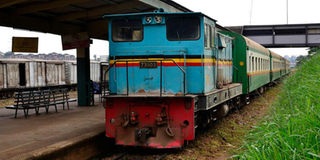Govt firms costing Ugandans heavily

Uganda Railways Corporation and Uganda Electricity Transmission Company Limited are among the worst performing government enterprises. File Photo
More than half of Uganda’s public enterprises are costing taxpayers heavily in losses and would be better managed under public-private partnerships, says a new report by the Auditor-General.
According to the report, only 14 out of the 29 state enterprises analysed made profits in 2018, with Bank of Uganda, National Social Security Fund and National Water and Sewerage Corporation posting profits of $114.5 million $64.8 million and $13.7 million, respectively.
The worst performing were Uganda Railways Corporation, Uganda Electricity Transmission Company Ltd and Civil Aviation Authority with losses of $25.1 million, $20.2 million and $5.6 million, respectively.
“There is a need for government to improve on supervision and monitoring of these entities by introducing performance-based contracts with clear targets. In addition, the government could also explore public-private partnerships,” read the report.
In addition to making losses, a number of companies are unable to meet their long-term debt.
“Four state enterprises had debt ratios of more than 50 per cent, implying that their total assets were insufficient to cover their total debt. These were Uganda Electricity Distribution Company Ltd, Uganda Electricity Generation Company Ltd, Uganda Electricity Transmission Company Ltd and National Water and Sewerage Corporation,” said AG John Muwanga.
All the state enterprises are independently managed, but are expected to operate efficiently, make profits and pay dividends to the government.
“Out of the 17 profit making enterprises, only New Vision Printing and Publishing Company proposed a dividend payout amounting to $540,243,” said Mr Muwanga.
Previous red flags
In 2017, the Auditor General pointed out that out of the of the 22 state enterprises, only 10 were “profitable.
Clarifying on the non-profitability of majority of state-owned enterprises, Auditor General John Muwanga observed in the report that at least seven State enterprises have debt ratios of more than 50 per cent implying that most of their assets are financed by debt.
“These enterprises are required to operate in a profitable manner and pay dividends to government but only one enterprise paid dividends to its shareholders in the year under review,” Mr Muwanga said.
He said Vision Group, incorporated as the New Vision Printing & Publishing Company Ltd, declared dividends of Shs3.8b. The loss making entities Mr Muwanga indicated in the 2017 report had “made losses from their operating activities, and advised their shareholders, especially government through the Ministry of Finance, to review their operations “with a view to turning them into profit making organisations.”
Some enterprises such as National Housing and Construction Company (co-owned with the Libyan government), Nakivubo War Memorial Stadium, Uganda Posts Ltd and Mandela National Stadium, the report showed were in a worse liquidity position “below the standard threshold” an indication that they were not able to cover their current obligations and continue operating.
Hugely indebted (2017 report)
The seven with debt fractions exceeding 50 per cent include two subsidiaries of the UPDF-run National Enterprise Corporation (NEC), NEC Construction works And Engineering Ltd and NEC Tractor Hire Scheme Ltd, Uganda Electricity Generation Company Ltd, National Water and Sewerage Corporation, Uganda Electricity Transmission Company Ltd, and Uganda National Cultural Center.
However, the report also shows the debt levels of others like National Housing, NEC Luweero Industries Ltd, Uganda Posts, and Uganda Railways to be soaring. Similarly, all the enterprises had varying degrees of negative return on assets with Kilembe Mines being in the most favourable position of 106 per cent.
Probelems of State enterprises
In 2017 Finance ministry spokesperson Jim Mugunga told Daily Monitor that the problems afflicting State enterprises range from management, oversight but most especially poor capitalisation, especially where government is a shareholder.
“Not all enterprises are under the Privatisation Act—Public Enterprises Restructuring & Divestiture—but those which are of course can be best explained differently,” Mr Mugunga said.
“Others have boards and shareholders and their governance structures follow that line. But some are purely as a result of capitalisation where government runs a more liberalised than a protectionist business and yet allows them to compete in the same sphere with private ones, which are run with less bureaucracy.”
The Auditor General’s report also documents some cases of wasteful spendings to a tune of Shs680m in among other cases, interest on breach of contracts and avoidable litigation costs.
For example, Uganda Aids Commission registered Shs35m in litigation costs arising out of irregular termination of staff contract and Rural Electrification Agency Shs178m in accumulated costs due to delayed settlement of taxes on contracts.
In the period, Uganda National Roads Authority Shs244m as interest charged on outstanding balance on payments to carry out advertising and construction, and Mandela National Stadium Shs156m as settlement of undisclosed domestic arrears.




